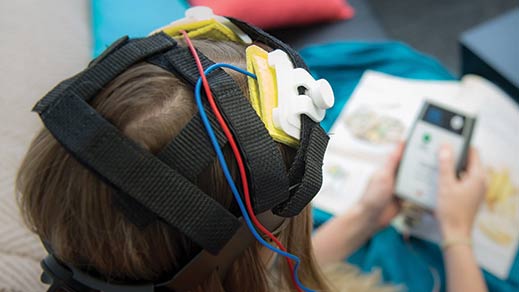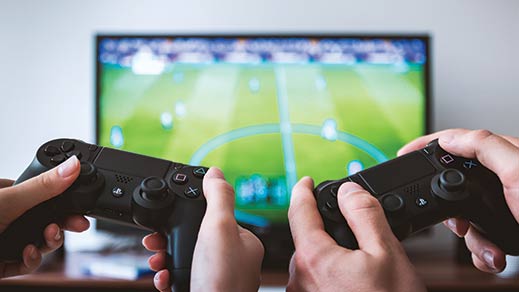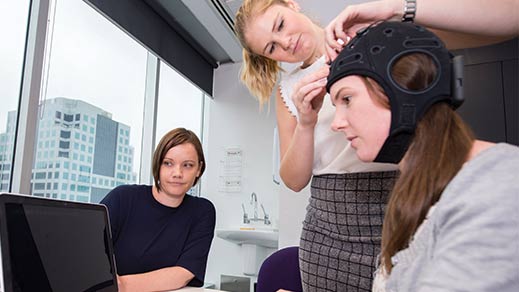A different kind of buzz
Expert reviewers
Essentials
- Transcranial direct current stimulation (tDCS) uses low levels of electricity to stimulate certain parts of the brain
- It is non-invasive, painless and considered to be safe
- tDCS is currently being trialled in the treatment of a range of mental disorders
- The technology is also being tested on ‘healthy’ brains to see if it can improve cognition and learning
- Experts do not recommend people attempt tDCS at home without proper training and supervision
- Research is ongoing…the effectiveness of tDCS has not yet been conclusively proven
As the electrodes are attached to my head I take a deep breath and try to put visions of Frankenstein's monster out of my mind. Instead, I put my trust in science. I’m about to have my motor cortex stimulated, which is the part of the brain responsible for gross-motor skills (movement).
Soon enough I feel the tell-tale buzz from the electrodes, which confirms that my brain is, at this very moment, being stimulated.
It’s a slightly strange sensation—a bit tingly, a bit itchy—but not unpleasant. I’d like to say that I immediately feel more focused, or more coordinated, but really I just feel a bit silly, sitting here with this device on my head being watched by a roomful of colleagues. My brain is stimulated for 20 minutes and then the machine is turned off. The slight tingle stops but my skin continues to prickle for a few moments longer.
So, what’s just happened to me, how and why did it work, and what could this be used for in the future?

What is tDCS?
Transcranial direct current stimulation (tDCS) is a non-invasive, painless and relatively simple form of mild brain stimulation. It uses constant low-level current (up to two milliamps) administered via electrodes attached to the scalp to stimulate targeted regions of the brain.
tDCS can administer three types of stimulation—positive, negative and sham. The anode (positively charged electrode) can stimulate/excite neuronal activity in underlying parts of the brain, while the cathode (negatively charged electrode) can inhibit/reduce brain-cell activity. The sham setting is used during scientific experiments as a control measure, or placebo, and therefore does not produce any effects on brain function.
Differing results have been documented depending on where you place the anode (+) or the cathode (-). For example, applying anodal stimulation over the motor cortex can potentially help improve your gross-motor skills, or ability to learn a motor task, by up-regulating activity in this region. Placing the anodal electrode over the dorsolateral prefrontal cortex, a brain region important for cognition, or ‘thinking ability’, may improve your attention, verbal fluency and memory, while both positive and negative stimulation of the occipital lobes can alter visual perception in patients.
The gentle nature of tDCS does not cause brain cells to fire but it does change their readiness to fire. In the case of anodal stimulation, tDCS acts to increase their excitability, allowing them to react more easily; while the opposite is true for cathodal stimulation, which dampens down spontaneous firing rates. Because our brains have the ability to change over time (known as neuroplasticity), this altering of neuronal excitability can potentially help to promote changes in brain function—the idea being that over time you may be able to strengthen synaptic connections important for cognitive processes such as learning and memory.
A session of tDCS generally lasts up to 20 minutes, and participants can be either active or passive. Active participants will undertake a task either during or shortly after the stimulation period, for example a cognitive activity such a sequence-learning, or a repetitive task such as playing a piece of music.
Passive participants do not perform any tasks either during or after stimulation.
This difference between a subject being active/passive during the session is an ongoing area of investigation. A lot of studies have just stimulated the brain and looked at the effects. There is quite a lot of evidence, in the motor cortex at least, that this will still lead to changes in cortical excitability (how likely the neurons are to fire). There is also some limited evidence that stimulation alone might lead to changes in cognition, such as working memory.
However, tDCS is perhaps most often combined with a training task, with the idea being that stimulation will augment the effects of that task leading to greater behavioural gains than if the task were just practised alone. In such cases it is likely that tDCS enhances that plastic effects that take place during the learning process. This has been reported in several tDCS studies.

During my session, I was passive, and nothing much seemed to change—I didn’t feel more focused or coordinated. But I wasn’t deterred; many of the effects of tDCS kick in afterwards—generally within the first hour after a session ends. Researchers sometimes refer to this as the ‘window of opportunity’ and, depending on the level and length of the initial stimulation, it can last between 30 and 90 minutes. It’s what you do during this time that can, at least in theory, begin to make changes to your brain.
So if you’ve had your motor cortex stimulated like I did, you may notice that 30 minutes later your typing speed improves or you show improved coordination. If you’ve had your dorsolateral prefrontal cortex stimulated, you may notice improved memory—that you’re more receptive to taking in and remembering information during this period.
Thirty minutes after my treatment I’m back at my desk and waiting to see if anything miraculous happens….am I typing faster? Is my handwriting more controlled… no, not that I can notice. I still feel the same and my coordination and gross-motor skills seem to be as they were before the treatment. I have to admit I feel a bit disappointed. However, I’m assured this is not unusual. For one thing, I only had a single session, whereas many studies utilise multiple sessions of tDCS across consecutive days, which can lead to more robust and longer-lasting effects than a single session.
And while applying tDCS to the motor cortex alone would increase underlying cortical excitability, it would be unlikely to improve performance without additional training. It seems even with brain stimulation, you can’t get something for nothing.
Potential uses of tDCS
If you believe everything you read on the internet, it seems that there’s nothing tDCS can’t do.
From a medical point of view it’s promoted as having the potential to relieve chronic pain, reduce the symptoms of brain disorders such as depression, Parkinson’s and other neuropsychiatric conditions, and assist in the rehabilitation of stroke patients.
In ‘healthy’ brains, it’s touted as being able to improve learning, intelligence, memory and focus, and aid your gross-motor skills. Interestingly it’s the use of tDCS in healthy brains that has garnered the most media attention, as buzz words like ‘brain-hacking’ and ‘neuro-enhancement’ are snapped up by mainstream media outlets. After all who wouldn’t want a ‘quick-fix’ to give them a mental edge?
Does it really work?
Well, the answer to that depends on who you ask. Since the year 2000 nearly 3000 scientific papers have been published on tDCS. Many of these claim that it does work…however a considerable number have also failed to find evidence of a significant effect of tDCS on either an individual’s behaviour or their underlying brain activity.
One of the issues is that trials of the technology are not uniform—they use different machines, electrode sizes, stimulation intensities and electrode locations, while the participants may also vary in age and circumstance. As tDCS is a relatively new technology, researchers are still trying to understand how all these factors affect the outcomes of stimulation. Additionally, many previous studies, particularly those conducted early on, used relatively small sample sizes and investigated effects after only a single session of stimulation. As such, the effects of tDCS, when present, were often quite variable and short-lived.
With so many variables it’s hard to find a clear consensus.

One way to get a clearer picture is to perform what is referred to as a meta-analysis—a statistical procedure that combines data from multiple studies to identify a common effect. Dr Jared Horvath from the University of Melbourne has recently published two meta-analyses of hundreds of tDCS studies (on healthy patients using a single tDCS session), which found no evidence of either physiological changes to the brain or of cognitive effects from tDCS in healthy participants.
Frustratingly, he noted that different studies tended to cancel each other out, for example, of four that analysed whether tDCS increased glucose metabolism in the brain, two of the studies said yes, and two said no. Despite this, Horvath believes tDCS has promise. He, like many other researchers, is advocating for a large, scientifically rigorous study with standardised protocols, so that results can more easily be compared.
However, other meta-analyses of studies on both healthy and clinical populations, as well as repeated stimulation sessions, have concluded that tDCS does show some efficacy for changing brain function and there is now increasing pressure on researchers around the world to conduct larger, more rigourous studies incorporating both behavioural and biological outcome measures to better explore the complex effects of tDCS on the brain.
So, even the meta-analyses can’t agree! One reason may be that tDCS is more likely to benefit clinical populations, in whom brain functioning is not optimal, but less likely to enhance function in healthy individuals in whom brain functioning is already near optimal. For those researchers who have found beneficial effects of tDCS, one of the bigger questions they are now trying to solve is, how can we better optimise the behavioural effects of tDCS, and how can we improve our understanding of the specific mechanisms by which it is able to modulate brain function?
DIY tDCS?
Build a sandpit for my kids? Sure, I’ll try it. Tile my own bathroom? Possibly. But do-it-yourself tDCS? I’m not so convinced about that. Yet it seems others are not so wary. The low cost, accessibility and relatively simple nature of tDCS machines has spurned a bourgeoning DIY community of advocates who purchase machines online for use at home. Currently the biggest market for home kits is university students wanting help to study, and gamers wanting to improve their skill levels.

Devices range in price from $15 to more than $500, or, if you want to save a buck, you can make your own kit at home using items such as teaspoons and batteries (now that doesn’t sound risky at all). The reasons people are using tDCS at home are varied. It’s possible some have read the positive results of lab-tested studies and believe that they can replicate those results at home. Others may believe the slick marketing of websites that claim tDCS can work miracles on a myriad of problems. And then, perhaps, some people are just curious.
But should we really be trying to stimulate our brains at home without the supervision of experts?
Almost unanimously, those in the professional field say ‘no’. When conducted by researchers in a controlled lab setting, with high quality, tested equipment and strictly enforced rules surrounding use, tDCS is considered to be safe and low risk. However, outside of this scenario, for example, when you attempt to DIY at home, a range of safety issues emerge. These include, but are not limited to:
- devices delivering incorrect wattage or being faulty
- burns on the skin from electrodes
- attaching electrodes to the wrong parts of the skull and therefore stimulating the wrong parts of the brain
- ignoring the recommended daily usage limits of 15–20 minutes
- long-term use over months or years with unknown effects on the brain.
In an open letter to those using DIY brain stimulation, leading academics cautioned ‘there is much about noninvasive brain stimulation in general, and tDCS in particular, that remains unknown’ and that a range of problematic issues, which may not be immediately evident to the home-user, need to be considered. These include:
- that enhancement of some cognitive abilities may come at the cost of others
- changes in brain activity may last longer than you think (or want)
- stimulation affects more of the brain than you think (or want)
- small difference in tDCS parameters (wattage, duration, placement of electrodes) can have a big effect
- tDCS effects are highly variable across different people and depend on a range of factors such as age, gender, hormone level and medications
- the risk/benefit is different if being used to treat a disease vs trying to purely enhance cognition in healthy subjects.
In closing they noted that ‘significant tradeoffs may be part of the bargain for functional gains’ and that ‘whatever brain changes occur may be long-lasting—for better or worse’.
Similarly, Professor Colleen Loo of The Black Dog Institute and UNSW issued a word of warning for DIY users of tDCS. ‘What you are doing is not trivial… Are you making irrevocable changes to your brain that may not be beneficial…we actually don’t know.’
And that’s the key thing here—researchers do not know exactly how or why tDCS use may affect you. Even if you do stick exactly to the stated voltage and only wear the device for short periods, factors such as how much hair you have, how sweaty you are or your hormone levels that day can change the way the brain reacts to the machine. Certain groups of people are also considered higher risk, including the elderly, young children, those with mood disorders, epilepsy or implants, or those recovering from stroke. When you consider just how complex your brain is, how little we actually know about how all its interconnections work, and how irreplaceable it is (heart transplant—maybe, brain transplant—nope), you have to ask yourself if DIY tDCS is worth the risk? I don’t know about you, but I’ll be tacking the tiling instead.
Where to from here?
There is no doubt that tDCS is exciting technology. If it can do even half the things some have claimed it can, it will produce real gains for us as individuals and as a society. However, this is science, not science-fiction, and more studies need to be done to establish that the technology really works and is safe long-term, and to better understand why it works. It’s easy to get excited about terms like ‘brain-hacking’ or to think there may be a simple cure for depression, but we need to temper our enthusiasm, especially in the case of DIY tDCS, until we know more. Because, when it comes to your brain, not all ‘hacks’ can be undone.

